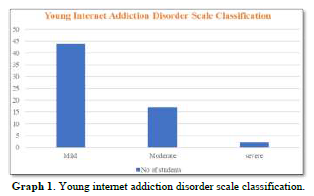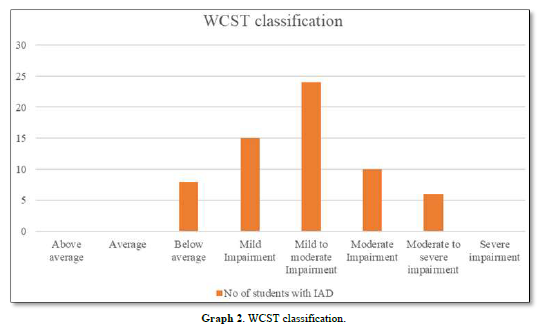121
Views & Citations10
Likes & Shares
HYPOTHESIS (H0)
There was no significant impact of internet addiction disorder on the cognitive functions of students with internet addiction.
OBJECTIVE
- The present study’s aim was to see the impact of IAD on cognitive functions
- The present study’s aim was to explore cognitive function components among students with Internet addiction disorder.
MATERIALS AND METHOD
The one-time assessment was conducted among university students between 18 and 30 years old in Delhi, India. A total of 148 samples were collected. Out of 148 students, 63 were addicted to the internet. The simple random sampling technique was used for data collection.
TOOLS DESCRIPTION
Socio-demographic and clinical data sheet: This data sheet will be developed for the present study by the researcher to obtain socio-demographic details of the participants. A brief clinical history concerning the onset of internet use, frequency of use, amount of use, abstinence period, treatment history, family history, and personal history will be assessed.
Young adult internet addiction disorder tests (Dr Kimberly Young): This scale was developed by Dr. Kimberly Young. It has 20 items that measure internet addiction behavior, including compulsivity, escapism, and dependency. Items also assess problems related to personal, occupational, and social functioning stemming from Internet use. Subjects respond to each statement with a number between 1 and 5, representing a Likert scale continuum, indicating the extent to which they endorse that particular behavior [3].
Wisconsin Card Sorting Test: The Wisconsin Card Sorting Test (WCST: Heaton, 1981) measures the ability to identify abstract categories and shift cognitive sets. Initially, several stimulus cards are presented to the participant. The shapes on the cards are different in color, quantity, and design. The person administering the test decides whether the cards are to be matched by color, design or quantity. The participant is then given a stack of additional cards and asked to match each to one of the stimulus cards for each. The participant is not told how to match the cards but is reassured whether a particular match is right or wrong. During the course of the test, the matching rules are changed, and the time taken for the participant to learn the new rules and the mistakes made during this learning process are analyzed to arrive at a score.
Table 1 shows socio-demographic details among students with IAD. Socio-demographics of central students have been taken based on characteristics: gender, education, marital status, residence, socio-economic status, family type, and religion. In the present study, a total of 63 data have been collected. Of these, 54.55% and females were 44.44% students with IAD. The data showed that males were using more Internet than females. Regarding marital status, 3.17% of students were married, and 96.82% were unmarried students with IAD. In education, 41.26% of students were undergraduate, 50.79% of students were under PG, and 7.93% of students were doing PhD who were internet addicted, which clearly showed that early age 18-24 years students were more affected by IAD. In terms of residence students with internet addiction, 19.04%% of students were from rural and 80.96% of students were from urban areas. In terms of socioeconomic status (SES), of students with an internet addiction disorder, 31.74% of students were low SES, 66.66% of students were from the middle class, in terms of family-type students with internet addiction, 15.87% of students were living in their joint family, 80.95.% of students were in their nuclear family, and 3.17% of students were in a broken family, in terms of religion, Hindu, 79.36% of students, Muslim, 15.87% of students, and 4.76% of students were Christian.
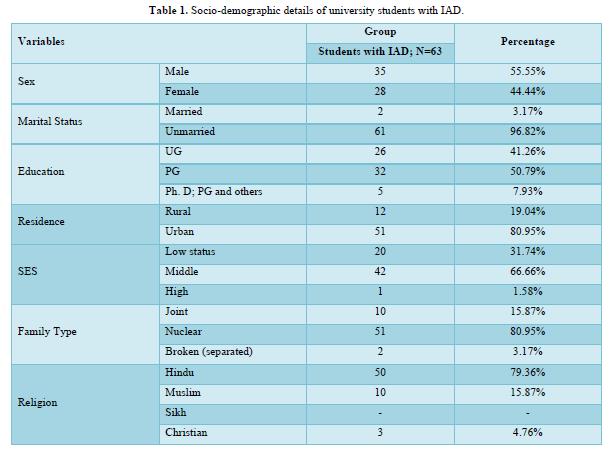
RESULTS
Table 2 showed results of internet addiction severity on young adult addiction disorder test. The mean was found to be 46.25 and SD 12.96, which indicates that students with IAD have mild to moderate levels of addiction to the internet. It is also categorized into mild, moderate, and severe groups.

Table 3 showed that 44 (69.04%) had mild levels of IA, 17 (27.0%) students had moderate levels of IA, and 2 (3.2%) students had severe IA [1]. The t-test value was 31.85, which is significant on <.001, and the effect size was 4. 01, which revealed a strong difference between the sample and the population (Graph 1).


Table 4 shows results based on previous research on IAD associated with cognitive functions [4]. The result showed a significant impairment in cognitive functions of IAD among students with IAD. WCST was used to investigate executive functions (cognitive functions). It was seen that internet addiction has a relation with executive functioning students with IAD on WCST total error domain mean was 73.76 and SD was 13.45. The second domain was the perseverative response. The mean score was 76.10, and the SD score was 29.92, which indicates that students with IAD have task-switching and cognitive flexibility problems [5]. The third domain was perseverative error response. The mean score of students with IAD was 89.40, and SD was 32.45, indicating below-average cognitive functions. This domain measured repetition, rigidity thinking, and repeated behavior. In the fourth domain, the non-perseverative response mean was 89.40, and the SD was 21.755, which indicates that students with IAD are below the level of executive functions. It indicates students' attention and impulsivity. Other studies support this result, finding individuals with non-perseverative errors associated with cognitive control deficits that create impulsive behavior [6]. The fifth domain was the conceptual level. The mean score was 76.93, and SD was 16.15. Results showed that students with IAD have mild to moderate level of conceptual levels. This domain indicates students' understanding and insight.
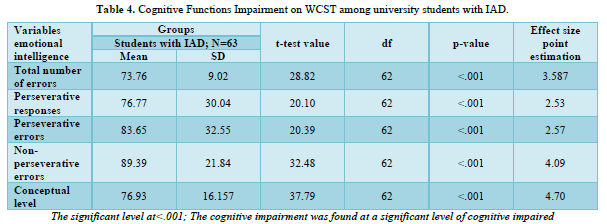
Table 5 showed clinical classification of students with IAD on WCST score categories. The result found that 12.69% of students had below-average cognitive functions, 23.80% had mild levels, 38.09% had mild-moderate levels of cognitive deficits, 15.87% had moderate impairment, and 9.52% had moderate to severe cognitive impairment. The finding of another study suggests that IAD-associated cognitive functions. Li [7] found a negative correlation between IAT scores and the medial prefrontal cortex and dorsolateral prefrontal cortex. They suggested that this may be a decrease in cognitive control and self-control [8-10] (Graph 2).
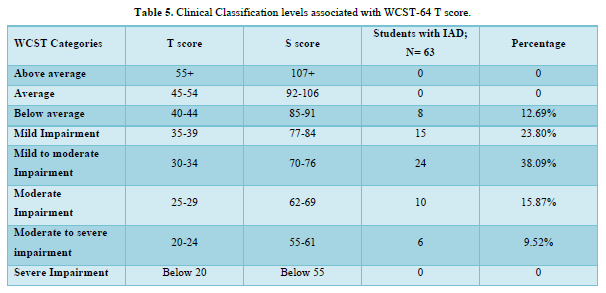
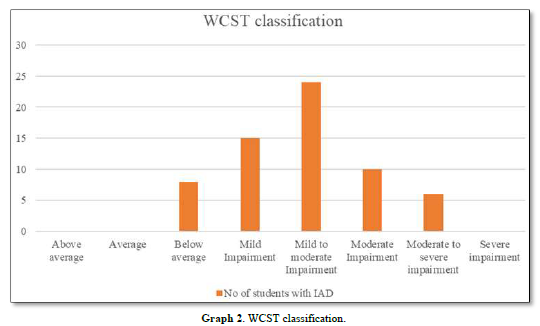
DISCUSSION
Descriptive statistics were used to describe the basic features of the data collected in the study, which include summaries about the sample and measures- percentages, frequency distributions, and central tendencies that describe the data collected.
CONCLUSION
The present study sees the impact of IAD on cognitive functions among university students with IAD. This research concluded that IAD impacts on cognitive functions of university students. They suffer from impaired attention, rigid thinking, poor problem-solving, impulsive behavior, and poor cognitive control. Students with poor cognitive function face daily personal, social, psychological, and emotional challenges. This research contributes to students with IAD's understanding of cognitive function impairments and, due to impairment, what types of problems occur in their personal and social lives.
- Kumari R, Langer B, Gupta R, Gupta RK, Mir MT, et al. (2022) Prevalence and determinants of Internet addiction among the students of professional colleges in the Jammu region. J Family Med 1(1): 325-329.
- Brand M, Young KS, Laier C (2014) Prefrontal control and internet addiction: A theoretical model and review of neuropsychological and neuroimaging findings. Front Human Neurosci 8: 375.
- Young KS (1998) Internet addiction: The emergence of a new clinical disorder. Cyber Psychol Behav 1(3): 237-244.
- Dong G, DeVito EE, Du X, Cui Z (2012) Impaired inhibitory control in ‘internet addiction disorder’: A functional magnetic resonance imaging study. Psychiatry Res 203(2-3): 153-158.
- Zhou Z, Zhu H, Li C, Wang J (2014) Internet addictive individuals share impulsivity and executive dysfunction with alcohol-dependent patients. Front Behav Neurosci 8: 288.
- West R (2003) Neural correlates of cognitive control and conflict detection in the Stroop and digit-lo tasks. Neuropsychologia 41(8): 1122-1135.
- Li W, Li Y, Yang W, Zhang Q, Wei D, et al. (2015) Brain structures and functional connectivity associated with individual differences in Internet tendency in healthy young adults. Neuropsychologia 70: 134-144.
- Brand M, Young KS, Laier C, Wölfling K, Potenza MN (2016) Integrating psychological and neuro-biological considerations regarding the development and maintenance of specific Internet-use disorders: An Interaction of Person-Affect-Cognition-Execution (I-PACE) model. Neurosci Biobehav Rev 71: 252-266.
- Dong G, Zhou H, Zhao X (2011) Male Internet addicts show impaired executive control ability: Evidence from a color-word Stroop task. Neurosci Lett 499(2): 114-118.
- Dong G, Lu Q, Zhou H, Zhao X (2010) Impulse inhibition in people with Internet addiction disorder: Electrophysiological evidence from a Go/NoGo study. Neurosci 485(2): 138-142.
QUICK LINKS
- SUBMIT MANUSCRIPT
- RECOMMEND THE JOURNAL
-
SUBSCRIBE FOR ALERTS
RELATED JOURNALS
- Journal of Otolaryngology and Neurotology Research(ISSN:2641-6956)
- Advance Research on Alzheimers and Parkinsons Disease
- Journal of Rheumatology Research (ISSN:2641-6999)
- International Journal of Radiography Imaging & Radiation Therapy (ISSN:2642-0392)
- Archive of Obstetrics Gynecology and Reproductive Medicine (ISSN:2640-2297)
- Journal of Pathology and Toxicology Research
- Chemotherapy Research Journal (ISSN:2642-0236)

